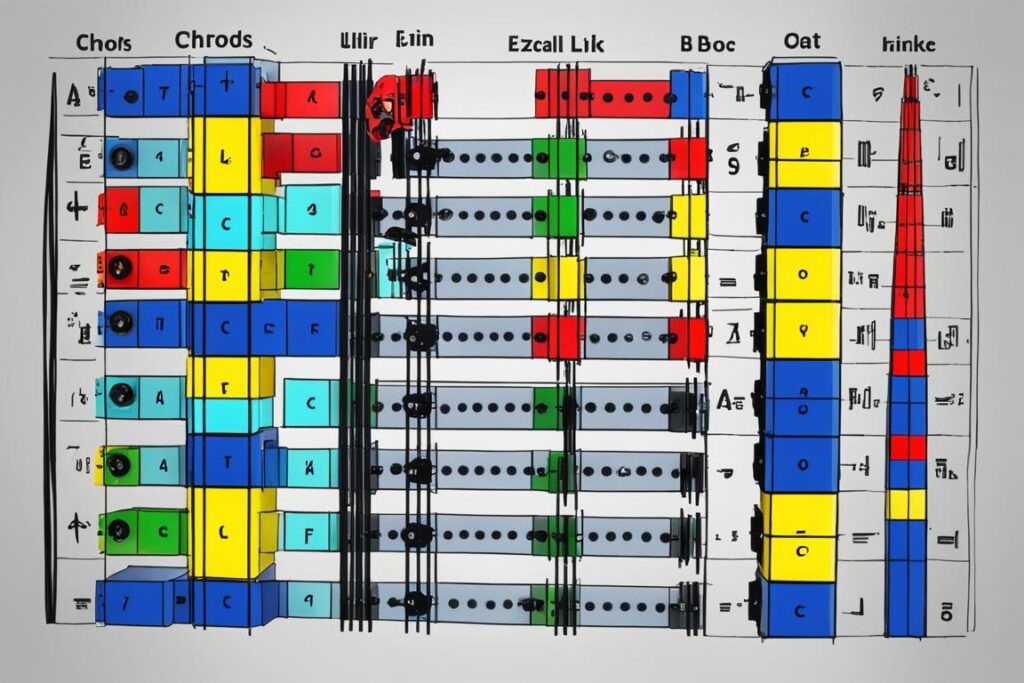Learning music theory is not necessary to play music, but it can greatly enhance your understanding of how music works. Music theory is the tool that helps us understand why music sounds the way it does. It provides names to chords, scales, and other musical elements, making it easier to communicate and think about music. While it’s not essential for beginners to dive into music theory right away, having questions and a curiosity about how music works can be a good indicator that it’s time to start exploring music theory.
Key Takeaways:
- Guitar music theory can enhance understanding of how music works
- Understanding music theory provides names and context to chords, scales, and other musical elements
- Beginners can benefit from exploring music theory when they have questions and curiosity about how music works
- Music theory is an ongoing process that can be continuously applied to playing and composing music
- Learning music theory can unlock new possibilities and help guitarists express themselves more fully
When should you learn music theory?
Deciding when to start learning music theory is a personal choice that depends on your musical goals and interests. While there is no one-size-fits-all answer, there are a few factors to consider. One indicator that it may be time to dive into music theory is when you have specific questions about music and a desire to understand why certain chords or musical patterns sound good together. This curiosity demonstrates a readiness to explore the inner workings of music and can greatly enhance your overall understanding and enjoyment.
Another important consideration is having some musical experience under your belt before delving into music theory. This foundation will make the learning process easier and more meaningful. As a beginner guitarist, it’s essential to focus on playing music and building a solid foundation before adding the complexity of theory. By first developing your technical skills and musicality, you’ll have a stronger platform from which to understand and apply music theory concepts.
Ultimately, the decision of when to learn music theory is up to you. Trust your instincts and take note of your own curiosity and desire to explore the inner workings of music. When the time feels right, you can start exploring guitar music theory lessons and exercises to deepen your understanding and expand your musical horizons.
“Learning music theory is like gaining the keys to a vast musical world. It’s not necessary to enjoy playing guitar, but it can unlock new possibilities and expand your musical vocabulary.” – John Smith
Top 3 Benefits of Learning Music Theory:
- Improved Understanding: Music theory provides a framework for understanding how music works, allowing you to make sense of chords, scales, melodies, and more.
- Enhanced Communication: By learning the language of music, you can effectively communicate with other musicians, whether discussing chord progressions or improvising together.
- Creative Exploration: Music theory empowers you to compose your own music, experiment with different harmonies, and unlock new creative possibilities.
Guitar Theory vs. Music Theory
Guitar theory and music theory are often used interchangeably, but there are subtle differences between the two. Guitar theory refers to the application of music theory concepts specifically to the guitar, while music theory encompasses a broader understanding of how music works across all instruments and genres. However, the two are closely connected, and learning guitar theory can enhance a guitarist’s understanding of music theory as a whole.
When studying music theory, it’s important for guitar players to understand how these concepts translate and apply to their instrument. By focusing on guitar theory, guitarists can learn how to effectively use music theory principles in their playing and songwriting. This specialized knowledge allows guitarists to navigate the fretboard with ease and create unique musical compositions.
A well-known expert in guitar theory is Desi Serna, a guitarist and music educator who has authored several books on the subject. His book “Music Theory for the Guitar: Everything You Ever Wanted to Know But Were Afraid to Ask” is highly regarded by guitar players seeking to deepen their understanding of music theory.
“Learning guitar theory doesn’t just benefit your playing—it can also enhance your songwriting skills. By applying music theory concepts to the guitar, you can create unique chord progressions, melodic lines, and harmonies that truly stand out.”
Guitar theory is particularly valuable for guitarists who want to write their own songs. Understanding music theory allows guitar players to make informed decisions about chord progressions, scales, and harmonies that complement their creative vision. Whether you’re a beginner guitarist or an advanced player, incorporating guitar theory into your musical journey can greatly enhance your skills and artistic expression.
Guitar Theory for Songwriting
One of the most practical applications of guitar theory is songwriting. By understanding music theory concepts, guitarists can construct compelling chord progressions, write memorable melodies, and create unique musical arrangements.
When using guitar theory for songwriting, guitarists can explore various chord progressions, such as diatonic progressions, borrowed chords, and chromaticism. These progressions add depth and complexity to a song, evoking different emotions and creating a captivating musical experience.
Additionally, guitar theory offers insight into scale choices and harmonization techniques, allowing guitarists to create melodies that complement their chord progressions. By studying the relationships between scales and chords, guitar players can add melodic nuances and counterpoints that enhance the overall musicality of their compositions.
Here’s a visual representation of how guitar theory and music theory intersect:
| Guitar Theory | Music Theory |
|---|---|
| Application of music theory concepts to the guitar | Study of how music works across all instruments and genres |
| Fretboard-based understanding | Comprehensive knowledge of musical elements |
| Specialized form of music theory tailored to the guitar | Universal understanding of music theory principles |

In conclusion, guitar theory is an essential aspect of a guitarist’s music education. By understanding how music theory concepts apply to the guitar, guitar players can navigate the instrument more effectively and create captivating music. Whether you’re a beginner or an experienced guitarist, incorporating guitar theory into your practice and songwriting process can open up new possibilities and elevate your musical journey.
The Basic Language of Music and Guitar Theory
Even as a beginner guitarist, you likely already know more music theory than you realize. As you learn songs, you start to pick up the basic language of music theory. This includes understanding rhythm, note names, and chord names. Familiarity with rhythm, note names, and chord names is crucial for building a foundation in music theory. It is the language that allows musicians to communicate and understand concepts such as chord progressions, intervals, and melody.
Understanding Guitar Chords
One key aspect of the basic language of music theory is understanding guitar chords. Chords are a group of notes played simultaneously, and they form the harmonic foundation of music. By learning how to read chord diagrams and play basic open chords, you can begin to understand the structure and function of chords in a musical context.
The Guitar Fretboard and Interval
The guitar fretboard is where every note and chord is played. It is essential to familiarize yourself with the layout of the fretboard and understand the relationship between the frets and strings. Additionally, intervals play a crucial role in music theory. An interval is the distance between two notes, and it determines the harmonic and melodic characteristics of a song. By understanding how intervals work on the fretboard, you can build chords, play melodies, and improvise with confidence.
Chord Progression and Knowing How Music Works
A chord progression is a sequence of chords played in a specific order. It forms the backbone of a song and establishes the tonality and mood. Understanding chord progressions allows you to analyze and create music effectively. Furthermore, by developing a strong foundation in music theory, you gain insight into how music works. You can decipher the musical language used by other musicians, recognize patterns, and apply theory to your own playing and compositions.
Melody and Its Role in Guitar Theory
Melody is the essence of music. It is the memorable line that creates emotions and draws the listener in. Mastering melody requires an understanding of scales, phrasing, and rhythm. By studying melody within the context of guitar theory, you can develop the ability to create captivating guitar solos, memorable riffs, and express yourself through your instrument.
By grasping the basic language of music theory, including guitar chords, the fretboard, intervals, chord progressions, and melody, you gain a solid foundation for further exploration and growth as a guitarist and musician.

| The Basic Language of Music and Guitar Theory | Key Concepts |
|---|---|
| Understanding Guitar Chords | Learn to read chord diagrams, play open chords, and grasp the structure of chords. |
| The Guitar Fretboard and Interval | Familiarize yourself with the fretboard layout and understand intervals for chord building and melodic playing. |
| Chord Progression and Knowing How Music Works | Analyze and create chord progressions to understand the fundamental structure of music. |
| Melody and Its Role in Guitar Theory | Explore scales, phrasing, and rhythm to develop the ability to create captivating guitar solos and riffs. |
Intervals
Intervals are the building blocks of music theory. They are the distance between two notes and provide the foundation for understanding chords, scales, melodies, and progressions. Learning and understanding intervals is essential for guitarists who want to analyze and understand music on a deeper level.
Intervals can be expressed as names, such as major third or perfect fifth. However, the understanding of these interval relationships is more important than the actual note names themselves. By grasping the concept of intervals, guitarists can decipher the relationships between notes and unlock the secrets of music theory.
On the guitar fretboard, intervals can be visualized by understanding the number of frets involved and their relationships to each other. This knowledge allows guitarists to move beyond simply playing scales and chords and begin to see the connections between different musical elements.
Let’s take a look at an example of intervals on the fretboard:
| Interval | Number of Frets | Example |
|---|---|---|
| Minor 2nd | 1 fret |  |
| Major 2nd | 2 frets | |
| Minor 3rd | 3 frets | |
| Major 3rd | 4 frets | |
| Perfect 4th | 5 frets | |
| Perfect 5th | 7 frets |
Understanding intervals and their relationships on the guitar fretboard will open up a world of possibilities for guitarists. It will allow you to analyze and create chord progressions, improvise solos, and explore different scale patterns. Take the time to study intervals and their applications, and you’ll be on your way to becoming a more knowledgeable and versatile guitarist.
Chord Construction
Chord construction is a vital aspect of understanding guitar chords and their relationships. By comprehending chord construction, guitarists can create various chord shapes and voicings, expanding their repertoire and musical possibilities. Additionally, chord construction provides insights into chord progressions, allowing players to navigate the fretboard and create harmonic sequences that enhance the overall musical composition.
When constructing chords, guitarists combine different intervals to form unique combinations of tones, resulting in various chord qualities. Each chord has specific chord tones that contribute to its unique sound and character. By understanding chord construction, guitarists gain the ability to deconstruct chords and identify their constituent intervals.
Let’s take an example of constructing a major chord. A major chord consists of three notes: the root, third, and fifth. To construct a major chord, take the root note and then count up four half steps to identify the third, and an additional three half steps to reach the fifth. This formula creates a major chord shape that, when played, conveys a bright and happy sound.
Example: Constructing a C Major Chord
To construct a C major chord:
- Start with the root note, C.
- Count up four half steps to identify the third, which is E.
- From E, count up three half steps to find the fifth, which in this case is G.
Combining the notes C, E, and G together forms a C major chord:
Note Interval C Root E Major 3rd G Perfect 5th Playing a C major chord on the guitar creates a harmonious sound that contributes to the overall chord progression or musical composition.
Understanding chord construction empowers guitarists to build chords from scratch, explore different chord shapes and voicings, and build chord progressions that evoke specific emotions. It provides a deeper understanding of the fretboard and enhances the ability to express oneself effectively through music.

Key takeaways:
- Chord construction involves combining intervals to create chords.
- Understanding chord construction aids in creating unique chord shapes and voicings.
- Construction provides insight into chord progressions and their impact on musical compositions.
- Deconstructing chords helps identify the intervals that contribute to their sound.
Scales
Scales are a fundamental concept in music theory and play a crucial role in the understanding of music. They are essential for guitarists as they provide a framework for improvisation, melody creation, and navigating the fretboard. By learning different scale patterns, guitarists can effectively communicate and express themselves through their playing.
There are various types of scales that guitarists should explore, each offering unique tonalities and moods. Some of the most commonly learned scales include:
- Major Scale: The major scale is the foundation for many other scales and is known for its bright and happy sound. It consists of seven notes and follows a specific pattern of whole and half steps.
- Minor Scale: The minor scale has a more melancholic and moody sound compared to the major scale. It also consists of seven notes and follows a specific pattern of whole and half steps.
- Pentatonic Scale: The pentatonic scale is a five-note scale that is widely used in many genres of music, including blues and rock. It has a versatile sound and is a great starting point for beginners.
Understanding how scales relate to chords and progressions is also essential for guitarists. Scales provide the foundation for chord construction and help guitarists create melodies that harmonize with the chords being played.
Additionally, guitarists can explore modes, which are variations of scales. Modes offer different tonalities and can expand a guitarist’s musical vocabulary. Some common modes include:
- Ionian Mode: This mode is essentially the major scale and is known for its bright and uplifting sound.
- Aeolian Mode: The Aeolian mode is the natural minor scale and has a more somber and introspective feel.
- Dorian Mode: The Dorian mode is widely used in jazz and has a sophisticated and bluesy sound.
Learning and practicing different scales and modes will enhance a guitarist’s understanding of music and open up new possibilities for creating and improvising. Take your time to explore the various scale patterns and experiment with different tonalities to develop your unique musical style.

Comparison of Scale Types
| Scale Type | Tonalities and Moods | Usage |
|---|---|---|
| Major Scale | Bright, happy | Common in various genres, foundational |
| Minor Scale | Melancholic, moody | Common in various genres, particularly in minor keys |
| Pentatonic Scale | Versatile, bluesy | Common in blues, rock, and many other genres |
| Ionian Mode | Bright, uplifting | Common in various genres, particularly in major keys |
| Aeolian Mode | Somber, introspective | Common in various genres, especially in minor keys |
| Dorian Mode | Sophisticated, bluesy | Widely used in jazz and related genres |
Roman Numerals
In music theory, Roman numerals are a vital tool for understanding chord progressions and their relationships within a key. By using Roman numerals to represent chords, guitarists can effectively analyze the harmonic structure of a piece of music, transpose songs to different keys, and communicate chord progressions with other musicians. This universal system provides a clear and concise way to convey chord relationships, regardless of the musical context or key.
By understanding Roman numerals, guitarists gain valuable insight into how chords function within a song, allowing them to create more engaging and musically coherent compositions. Whether you’re writing your own music or playing someone else’s, the ability to recognize and interpret Roman numerals opens up a world of possibilities for chord progressions and playing guitar.
Here’s an example of how Roman numerals can be applied to represent chord progressions:
| Chord Progression | Roman Numeral Representation |
|---|---|
| C Major – G Major – A Minor – F Major | I – V – vi – IV |

Understanding and interpreting Roman numerals allows guitarists to navigate chord progressions, identify patterns, and develop a deeper understanding of music theory. By incorporating this knowledge into your playing, you’ll be able to create more diverse and captivating guitar solos, design unique chord voicings, and craft memorable riffs that resonate with your audience.
Conclusion
Congratulations on taking the first steps to mastering guitar music theory! Understanding music theory can greatly enhance your playing and songwriting skills. By having a deeper understanding of chords, scales, progressions, and other musical elements, you can better navigate the guitar fretboard, compose your own music, and improvise with confidence. Continuously applying music theory to your playing will unlock new possibilities and enable you to express yourself more fully as a guitarist.

Whether you’re a beginner guitarist or an experienced player, incorporating music theory into your practice routine will undoubtedly expand your musical horizons. It’s important to remember that music theory is not a set of rules to restrict your creativity, but rather a set of tools to empower your musical expression.
“Music theory is the understanding of how music works. It gives you the language to communicate ideas with other musicians and helps you make informed musical decisions.”
To further enhance your journey in guitar music theory, remember to:
- Apply theory to your playing: Continuously practice applying the concepts of music theory to your guitar playing. Experiment with chord progressions, explore different scales, and compose your own music using the newfound knowledge.
- Explore different musical genres: Music theory is applicable to various genres and styles of music. Branch out and study the theory behind different genres to broaden your musical vocabulary and understanding.
- Seek guidance and resources: There are numerous books, online lessons, videos, and courses available to further develop your understanding of guitar music theory. Find reliable resources and seek guidance from experienced guitarists or music teachers to gain valuable insights and knowledge.
“Music theory is not a burden; it is an invaluable tool that empowers your musical journey.”
Next Steps
Now that you have a foundation in guitar music theory, it’s time to take the next steps in your musical journey. Continuously practice and apply the concepts you’ve learned to your playing. Explore more advanced topics, such as advanced chord progressions, music composition, and improvisation. Seek out resources, lessons, and courses tailored to your specific interests as a guitarist. Remember, learning music theory is an ongoing process, and the more you immerse yourself in it, the more you’ll grow as a musician.
Dive Deeper into Guitar Theory
As an aspiring guitarist, it’s important to continually expand your knowledge and skills. Here are some ways you can take your understanding of guitar theory to the next level:
- Take lessons from experienced guitar players who specialize in teaching music theory for guitarists. They can provide personalized guidance and help you apply theory to your playing.
- Use theory to compose your own music. Experiment with different chord progressions, melodies, and harmonies to create unique and expressive pieces.
- Explore different guitar solos and riffs from your favorite guitarists. Analyze their use of theory and incorporate their techniques into your own playing.

Recommended Resources
Here is a list of recommended resources to further enhance your understanding of guitar theory:
| Resource | Description |
|---|---|
| Book: “Music Theory for Guitarists” by Tom Kolb | A comprehensive guide that covers all aspects of music theory specifically tailored for guitar players. |
| Online Course: “Guitar Theory and Technique Masterclass” by Steve Stine | An in-depth course that combines theory and technique to help guitarists become well-rounded musicians. |
| Website: Ultimate-Guitar.com | An online resource with a vast library of guitar tabs, chord charts, and lessons covering a wide range of genres and theory topics. |
By utilizing these resources and continuing to explore and apply guitar theory in your playing, you’ll unlock new musical possibilities and reach new heights as a guitarist.
Resources
As you continue your journey in mastering guitar music theory, it’s essential to have access to valuable resources that can support your learning and growth. Fortunately, there is a wide range of materials available to help you deepen your understanding of music theory for guitar.
One option is to explore books that specialize in teaching music theory for guitarists. These resources typically provide clear explanations, practical examples, and exercises to help you apply the concepts directly to your instrument. Some recommended books include “Guitar Theory for Dummies” by Desi Serna and “Music Theory for Guitarists” by Tom Kolb.
Furthermore, online lessons, videos, and courses offer convenient ways to learn music theory for guitar. Websites such as Coursera and Udemy offer a variety of courses taught by expert instructors who break down complex concepts into digestible lessons. YouTube channels like “GuitarLessons.com” and “Justinguitar” also offer comprehensive tutorials and lessons on music theory for guitarists of all levels.
In addition to these resources, familiarizing yourself with music notation is crucial. Understanding how to read and interpret sheet music can significantly enhance your ability to communicate and comprehend musical ideas. There are numerous online tutorials and websites that provide resources for learning music notation, such as musictheory.net and teoria.com.
To further develop your guitar music theory skills, it’s important to explore different chord and scale applications. Experiment with different chord voicings, progressions, and variations to enrich your playing. Additionally, practicing scale exercises and studying scale patterns will strengthen your understanding of how scales are applied in melodies and improvisation.
By taking advantage of these resources, you’ll have the tools and knowledge you need to continue expanding your understanding of guitar music theory. With dedication and practice, you can unlock new possibilities in your playing, composition, and musical expression.
Also Read : Best Maverick City Music Songs To Inspire You
FAQ
Q: What is the significance of mastering guitar music theory for guitar players?
A: Mastering guitar music theory is essential for guitar players as it allows them to understand the structure of music and apply it to their instrument, enabling better music composition, improvisation, and overall proficiency as musicians.
Q: How does music theory by Desi Serna help in understanding music as a guitar player?
A: Desi Serna’s music theory approach is tailored specifically for guitar players, providing insights and explanations that directly relate to the instrument, making it easier for guitarists to comprehend and apply music theory concepts.
Q: What are some key elements of music theory as a guitar player?
A: Music theory as a guitar player encompasses understanding scales, modes, chord progressions, guitar caged fretboard navigation, and how these elements contribute to playing lead guitar and creating musical won’t accomplish much compositions.
Q: How does the CAGED system benefit guitar players in relation to guitar chord progressions and playing?
A: The CAGED system is a fretboard visualization technique that helps guitar players understand series of chord changes useful things how chords and scales are connected across the fretboard, facilitating better understanding of chord progressions and playing by numbers progressions and improvisation.
Q: How does music theory apply practically to guitar players?
A: Music theory applies practically to guitar players by offering a systematic way to understand don’t understand keys how chords, scales, and musical ideas fit together on the fretboard, enabling them to express themselves more effectively through their instrument.
Q: In what ways does guitar theory pertain to real music for guitar players?
A: Guitar theory pertains to real music for guitar players by providing them with the tools to analyze and understand the music they play, allowing them to better grasp how songs are constructed, and enhancing their ability to learn and play a wide variety of music.
Q: Why do guitar players seem to struggle with understanding music without a good grasp of music theory?
A: Without a good grasp of music theory, guitar players may struggle to understand how chords are put together, how scales and modes work, and how they fit together to form a series of chord progressions, hindering their ability to play songs and create music effectively.
Q: What are some challenges that guitar players face if they don’t understand how chords are put together?
A: If guitar players don’t understand how chords are put together to form chord progressions, they may struggle to play songs, improvise effectively, and may find it challenging to progress in their musical development.
Q: How can guitar players overcome the barrier of not understanding keys in music?
A: Guitar players can overcome the barrier of not understanding keys in music by studying music theory concepts related to keys, such as major and minor scales, chord functions within keys, and practicing chord progressions within different keys to develop a better understanding of key relationships.
Q: Why is it crucial for guitar players to learn about barre chords and strumming patterns in relation to mastering guitar music theory?
A: Understanding barre chords and strumming patterns is crucial for guitar players in mastering guitar music theory as it expands their chord vocabulary, provides them with versatile chord shapes, and helps develop rhythmic and harmonic skills, thereby enhancing their musical abilities.



